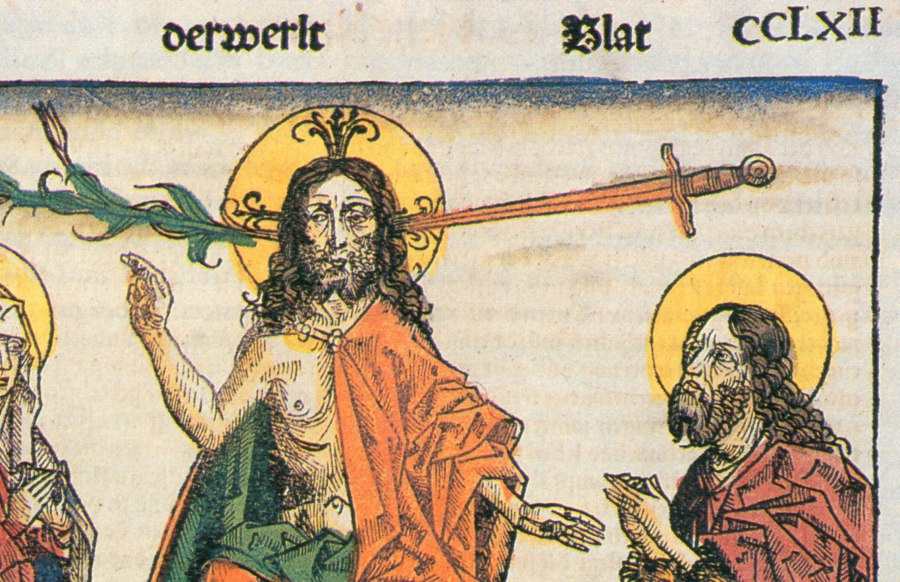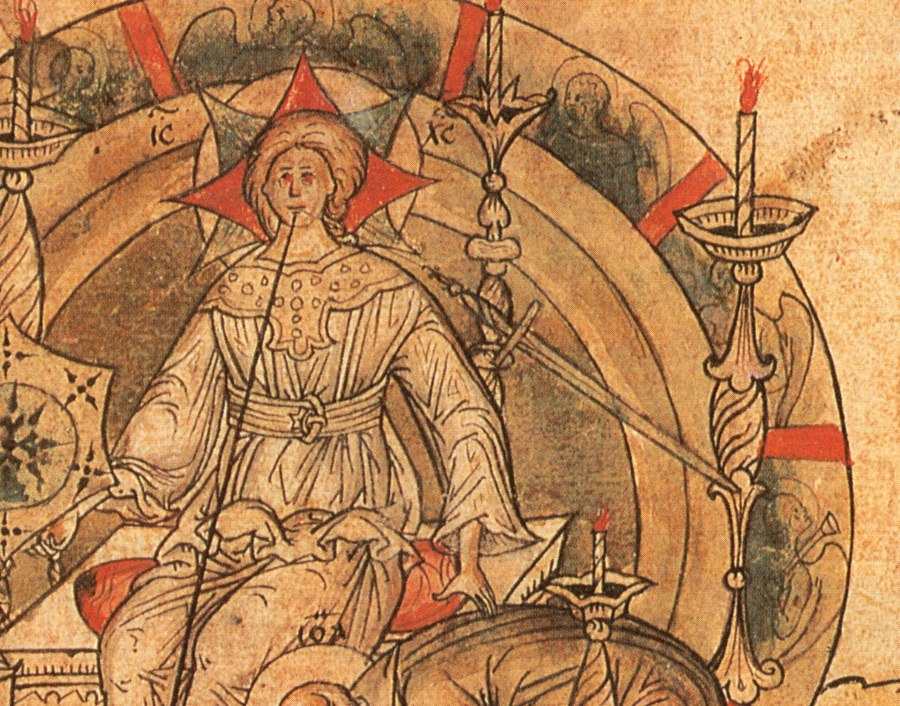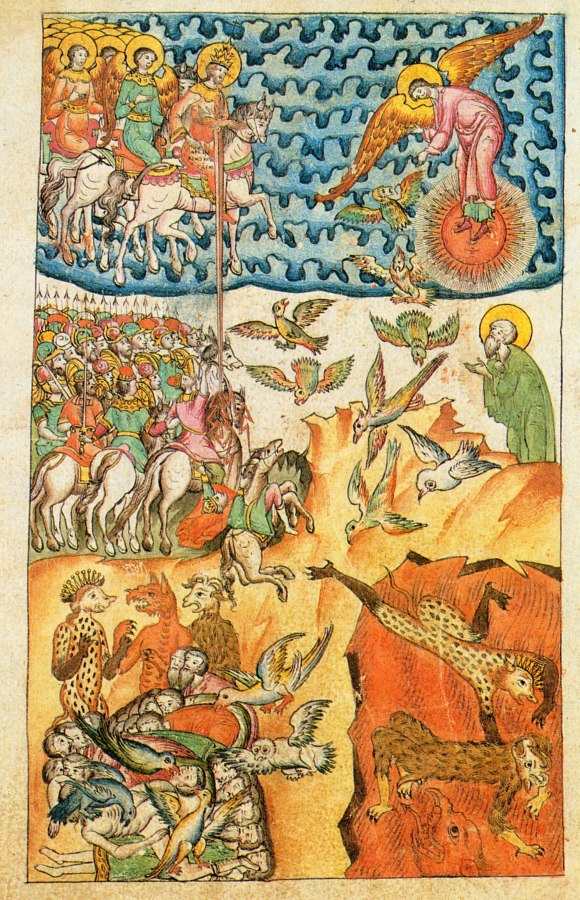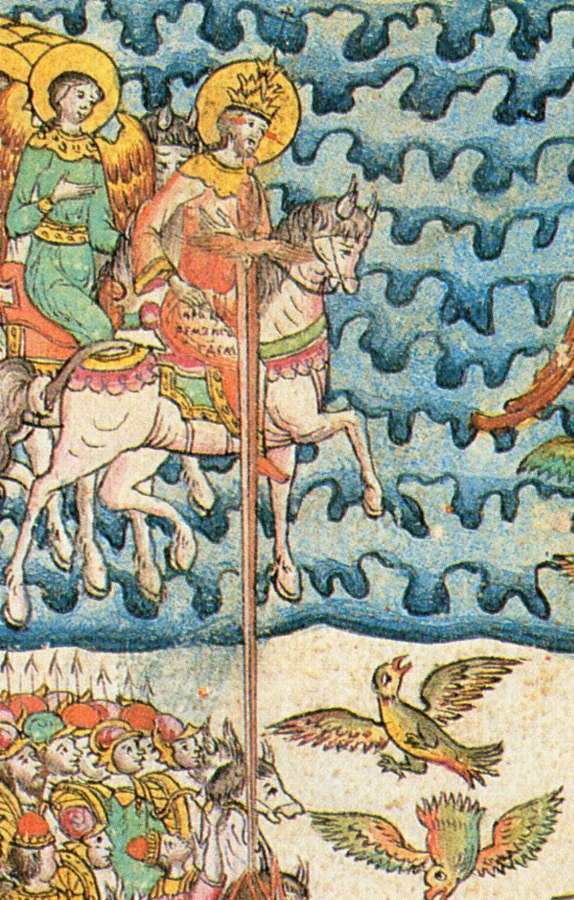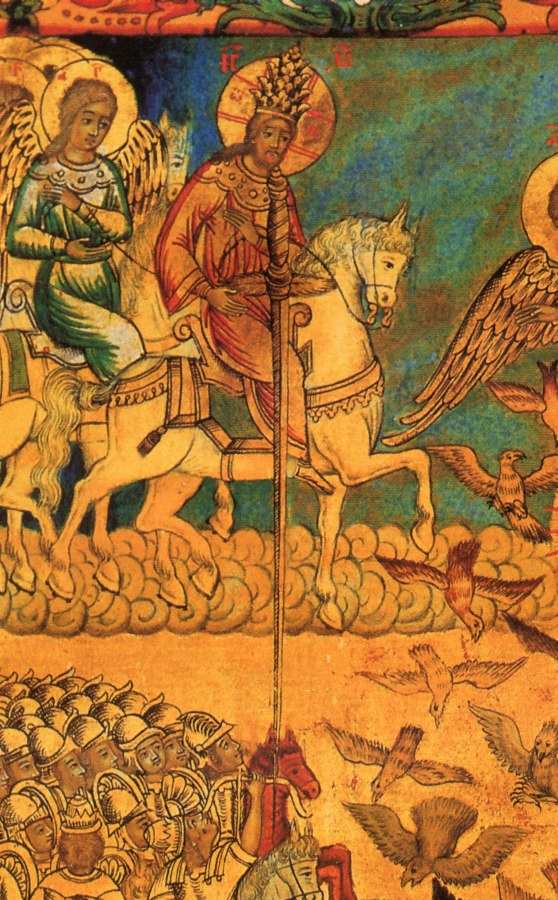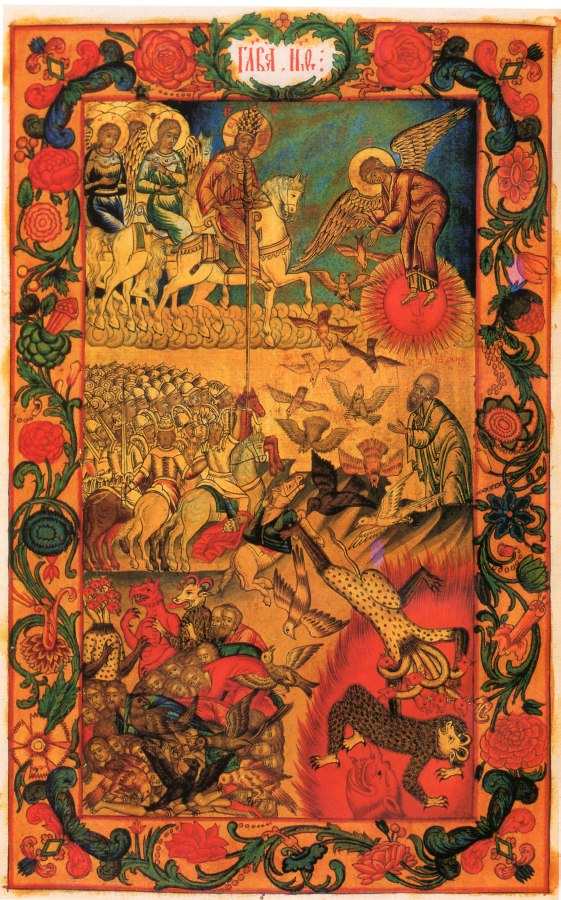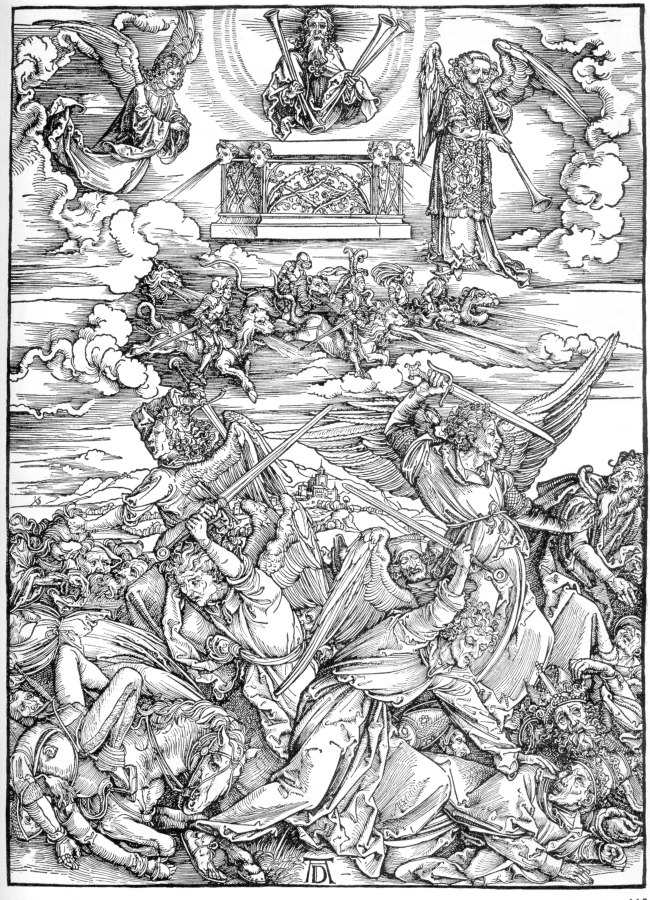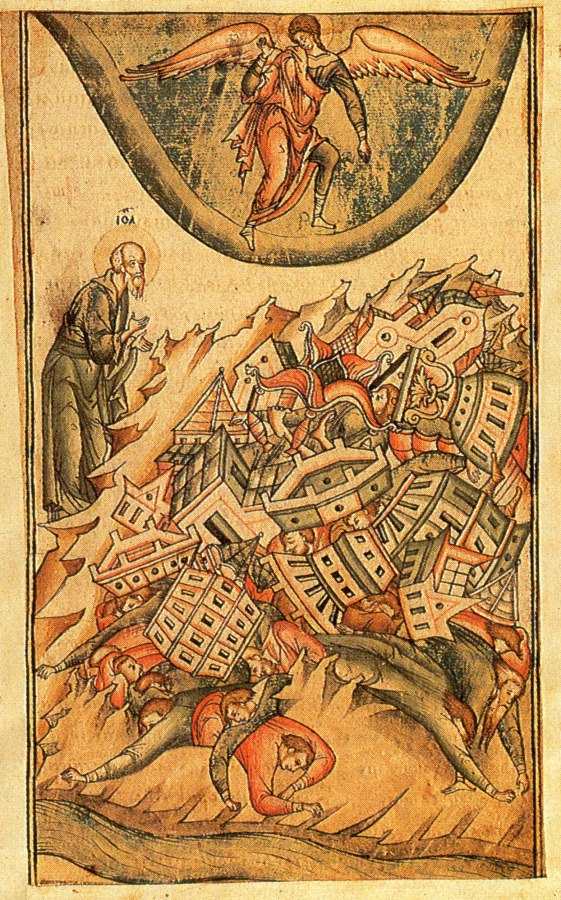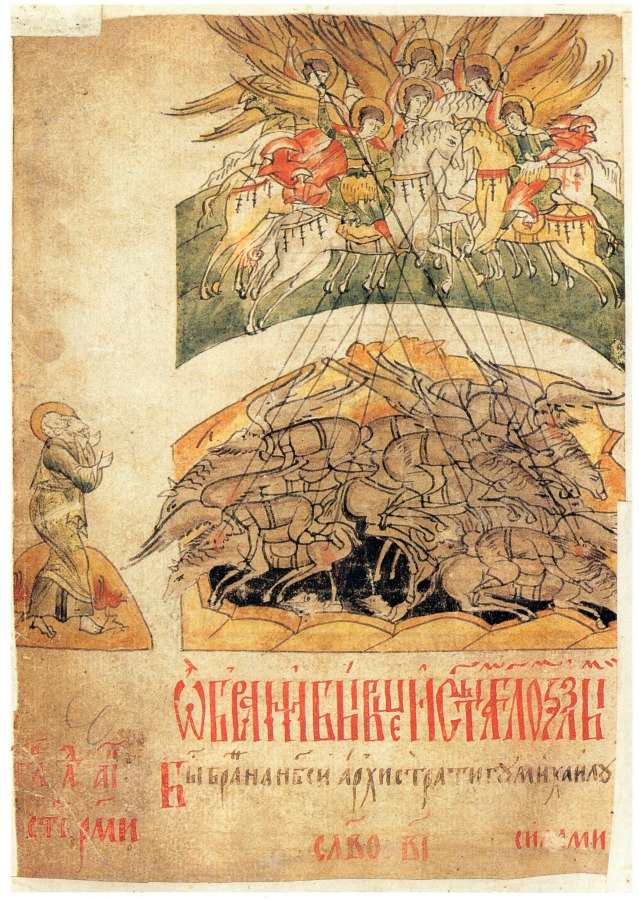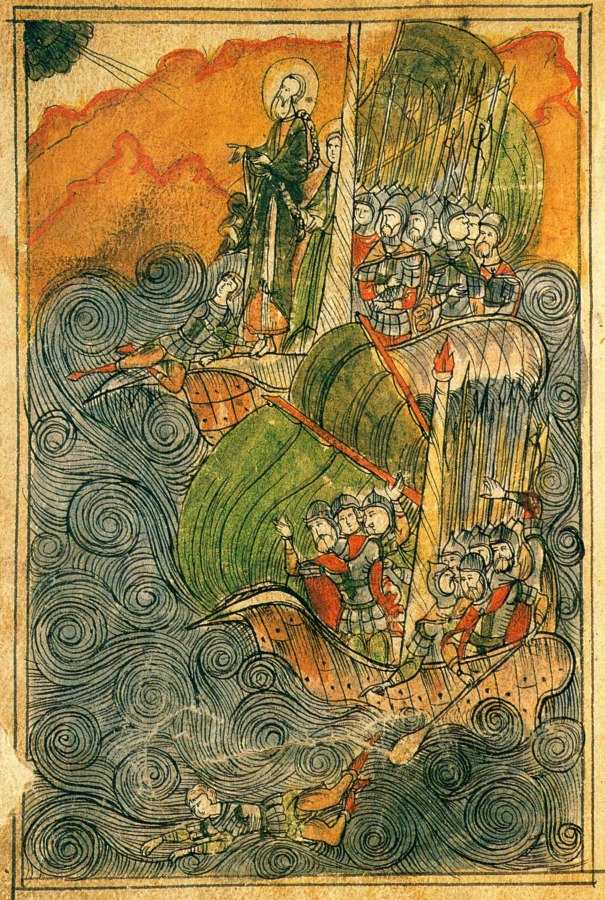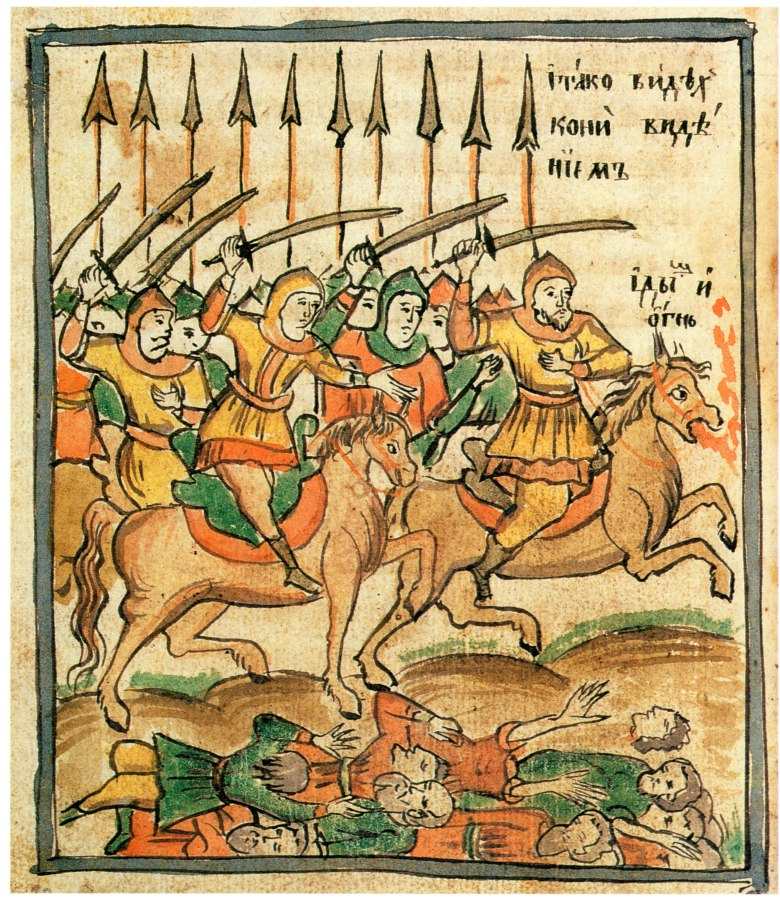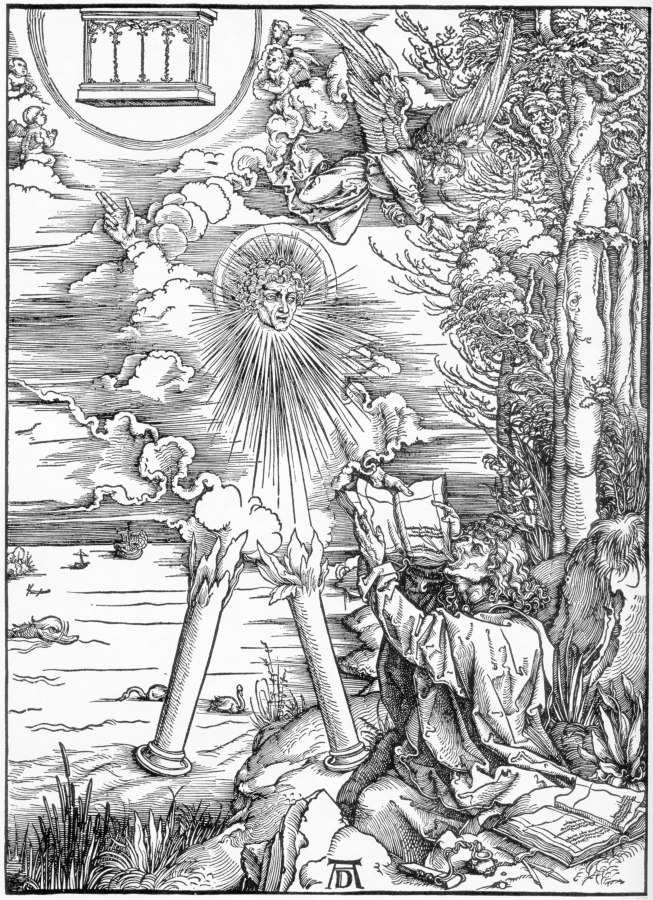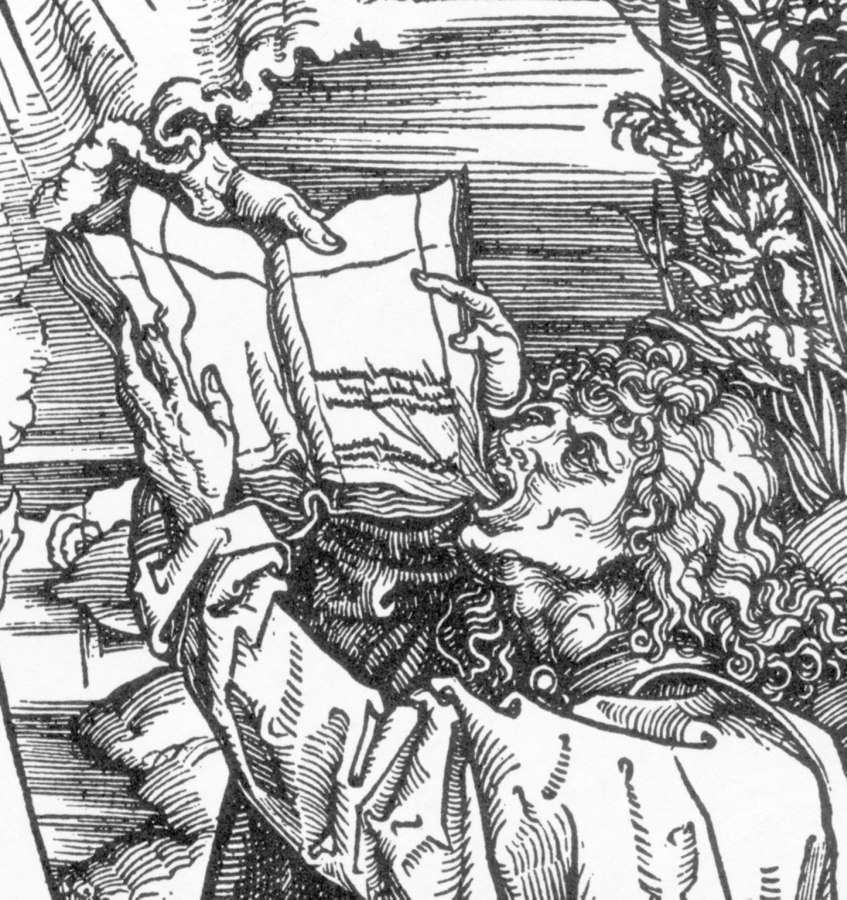ADDENDUM 2.
The Biblical Book of Revelation refers to the Ottoman = Ataman Conquest of the XV-XVI century.
1. A brief rendition of the Apocalypse.
The Book of Revelation is believed to be the Bible’s most mysterious and obscure part. It used to be referred in the following manner, for example: “‘The obscurity of this book does not preclude us from marvelling at it. If I fail to understand it in its entirety, then my own ineptitude is the only culprit. I cannot act as the judge of truths that it contains and measure them with my mere mortal’s mind – I can only acknowledge them as thoroughly beyond my comprehension, and let my faith guide me, not my mind’. This is what St. Dionysius of Alexandria wrote about the most enigmatic and symbolic book of the New Testament – the Book of Revelation. It is known as the Apocalypse of St. John in Greek” ([623], page 5).
Let us recollect the content of the Apocalypse.
John is on the Isle of Pathmos when he has a vision: Jesus Christ (Son of Man) addresses the seven churches and demands that John write down everything he sees or hears. The seven churches are named, and Jesus addresses each one of them and says that the deeds of the church are known well to him and that he knows its rights and its wrongs.
Then John sees the following happen in the sky. A throne appears, with the Sitter (Jesus) sitting thereupon and four animals accompanied by twenty-four old men gathered round about. The Sitter is holding a sealed book and the Lamb who has the right to open the seals. The seals are opened one by one and forth come the four riders of Apocalypse, bringing death and destruction. A global catastrophe unfurls. This is the very fragment of the Apocalypse that contains an astronomical horoscope, which was discovered by N. A. Morozov and received a final dating in CHRON1, Chapter 3.
Seven angels come forth, bearing horns. As soon as one of them blows a horn, a new affliction, or punishment, befalls the Earth. Many people die. The angel shows John a book that the latter must devour so as not to disclosed what it says. Instead, John must write another book, one that will be known to the people. One reads about two witnesses of God, the demise of the nations and their ascension to heaven. The kingdoms of the nations become the kingdom of God. A woman appears in the sun, bearing a child. A dragon assaults her; she escapes into the desert. The dragon is cast down to the ground. A beast of seven heads and ten horns appears, followed by a beast with two horns, whose number is 666.
The lamb stands on Mount Zion with the hosts of the saved. Jesus pronounces his judgement. The seven angels are given seven vials of God’s wrath with sores and pour them onto the ground. The fall of Babylon is predicted. The people are ordered to leave Babylon in order to avoid the sores; Babylon perishes abandoned. Heavens rejoice at the fall of Babylon. The Beast is thrown into a lake of fire. Satan is bound into chains, the true followers of Christ reign for a thousand years. Satan becomes unbound and is thrown into the lake of fire. The dead stand in front of the great white throne. John sees the new heaven and the new earth, as well as New Jerusalem. The nations are saved.
Quite obviously, it is rather difficult to give a brief rendition of the Apocalypse. Its text is fragmentary, heavy, convoluted and overloaded with symbolism. Therefore, we recommend the readers to refer to the complete text of the Apocalypse while reading this Chapter of our book.
The traditional ecclesiastical point of view claims the Biblical Apocalypse, or Revelation of St. John, to be a prophecy and herald future events. Our results demonstrate this to be incorrect. Most probably, the Apocalypse describes events of the past – more specifically, mediaeval events that were extremely important for the entire history of Eurasia. The outstanding popularity that the book has enjoyed for centuries and the crucial role of the images it contains reveal the paramount importance of the events reflected therein.
According to the astronomical dating of the horoscope contained in the Apocalypse, the book was written in 1486 A. D. the earliest, see CHRON2, Chapter 3. In this case, Apocalypse must also describe other events dating from the late XV – early XVI century. Which ones? As soon as the question is formulated, our reconstruction helps us find the answer with sufficient ease.
We shall voice our hypothesis immediately, at the very beginning of the present section, and then provide argumentation in order to prove it.
The Apocalypse is most likely to describe the Ottoman = Ataman conquest of the XV-XVI century – in particular, the second conquest of the Western Europe as part of the Promised Land. The Book of Revelation in its modern form appears to have been conceived as an important ideological and edifying oeuvre whose purpose was to constantly remind the nations and their descendants about the Ottoman = Ataman Conquest, described in the Book of Revelation as the Judgement Day.
Let us now go over the main topics of the Apocalypse and attempt to find out just which XV-XVI century events they reflect.
2. The warlord Joshua son of Nun as the “second coming” of Jesus Christ in the XV-XVI century.
The Apocalypse is based on the idea of the second coming. It begins with the following words: “The Revelation of Jesus Christ, which God gave unto him, to shew unto his servants things which must shortly come to pass” (Rev 1:1). Elsewhere in the New Testament (Paul’s Epistle to Hebrews) we read the following: “So Christ was once offered to bear the sins of many, and unto them that look for him shall he appear the second time without sin unto salvation” (Hebrews 9:28). The essence of the Apocalypse is usually encapsulated as follows: Jesus Christ makes a second coming to Earth, pronounces his last judgement on the people and takes the righteous with him to New Jerusalem in heaven, whereas all the sinners are cast into inferno. These are the very motifs that we see on the numerous visual representations of the Apocalypse (church artwork, holy books, icons etc).
According to our reconstruction, Jesus Christ (1152-1185) lived in the XII century (the emperor Andronicus-Christ, also called Russian Prince Andrey Bogolyubsky, idem Apostle Andrew the First, was crucified in 1185 in Czar-Grad; see our book "The Czar of the Slavs"). The Ottoman = Ataman conquest took place some 300 years later, in the XV-XVI century, initially led by Moses and then continued by the great military leader Joshua, Son of Nun – possibly, “New Jesus” or “Jesus the Second”. It is described in the books of Exodus and Joshua as the conquest of the Promised Land by the Israelites (Theomachists), qv in CHRON6, Chapter 5. It is likely that this seminal epoch was described in the Book of Revelation as the second coming of Christ.
It would also be apropos to point out that the Koran, for example, confuses Jesus for Joshua and vice versa (see CHRON4, Chapter 19:49 and CHRON1, Chapter 7:6.5 for more detail).
3. The Great Apocalyptic Judgement as the invasion of the Ottomans = Atamans to the Western Europe in the XV-XVI century.
Bear in mind that the invasion of the Ottomans = Atamans was a great shock for the entire world and not just the Western Europe. According to our reconstruction, the invasion swept over the entire Western Europe – the reasons behind it were described in great detail in CHRON6, Chapters 4-5. As we mentioned earlier, one of the reasons was the fight against diseases that spread over large areas of the Western Europe and the Mediterranean region. The foundation of the Great = “Mongolian” Empire in the XIV century was accompanied by the construction of numerous roads used by everyone, and not just the traders and the warriors – travellers, regular populace and adventurers alike.
Therefore, epidemics that broke out in a certain area soon spread over vast territories. As we have explained it in CHRON1, Chapter 7:3, the mediaeval Western European Christian cult, or the “ancient” pagan bacchanals of the XV-XVI century, resulted in a wide propagation of contagious diseases – not only of the venereal kind. The Khans of the Empire were confronted by a grave problem. The level of medicine in that epoch must have been primitive, and the reasons behind diseases were perceived rather vaguely, likewise the mechanisms of contagion. Therefore, the medics could offer no effective methods of mass treatment. And so the Khans of the Empire made the only decision that must have struck them as right – to use military power in order to destroy the populace of the contaminated regions. The residences of the infected were to be burnt; the warriors received orders to make no contacts with the diseased. It was also ordered to disinfect the swords and the weapons in general with the aid of fire and boiling water.
This is reported unequivocally in the books of Exodus and Joshua (see CHRON6, Chapters 4-5 for more detail). And so, after much consideration, the unpopular decision was made and then enforced with an iron hand. Quite obviously, the population of the Western Europe (for the most part, the offspring of the same “Mongols” from the Horde who conquered the sparsely populated Europe in the XIV century, during the Great = “Mongolian” conquest) rebelled against this order of the Khan, or their Emperor – nobody wanted to die.
Everyone took to arms, even the diseased, in order to fend off the onslaught of the Ottomans = Atamans. The descendants of the Horde’s first wave of expansion collided with the second wave, one that came from the Horde as well. Both parties were good fighters. A war broke out as a result. And yet the orders of the Khan, or the Emperor, were carried out in full. The resistance was crushed. These events proved a great shock to the Europeans, and they are most likely to have become reflected in the Book of Revelation as Judgement Day.
The entire Book of Revelation is saturated with sombre images of the Judgement Day. The Christian tradition believes the Apocalypse to be the quintessential description of the judgement pronounced upon humanity, one that cannot be evaded by anyone. The military aspect of events is constantly emphasised – Jesus is portrayed with a sword constantly throughout the book: “These things saith he which hath the sharp sword with two edges” (Rev 2:12); “His eyes were like a flame of fire . . . and out of his mouth went a sharp two-edged sword” (Rev 2:14 and 2:16); “And out of his mouth goeth a sharp sword, that with it he should smite the nations: and he shall rule them with a rod of iron: and he treadeth the winepress of the fierceness and wrath of Almighty God” (Rev 19:15). And so on, and so forth.
It is significant that the word “mouth” must have been added by latter editors of the book, or is a corrupted version of some other word used in order to mask the blatantly military picture of a massacre that is revealed to us otherwise. The editors of the Apocalypse took the sword away from the warlord’s hand and put it into his mouth instead, having thus transformed a two-edged sword as used on the battlefield into a mere metaphor. This is how the mediaeval illustrators of the Book of Revelation were forced to represent Jesus – with a sword coming from his mouth (see the famous engraving of Albrecht Dürer that illustrates the Apocalypse, for instance – fig. d2.1). The result looks rather uncanny – the sword is hanging in midair, barely touching the mouth. The implication is that the sword in the hand of Jesus wasn’t a real sword of steel, but rather some abstract “sword of words” coming from his mouth. Reality was replaced by a vague allegory.
Later on, the confused mediaeval artists tried hard to decipher this strange symbolism of the Apocalypse. Traces of these attempts can be seen almost everywhere. For example, in the illustration to the Book of Revelation contained in Hartmann Schedel’s famous “Global Chronicle” (allegedly dating from 1493) Jesus is drawn with a sword that is directed towards his ear, no less (see figs. d2.2 and d2.3). For some reason, the artist decided that it would be more “natural” to represent the strange indication of the Apocalypse about the two-edged sword coming from the mouth of Jesus in this manner. The illustrator tried to move the sword sideways from god’s mouth – however, his version remains rather odd. At any rate, the signs we see testify to the conflict between the common sense of the mediaeval illustrators and the rigidity of ecclesiastical authority. Some of the artists must have retained the memory that the Book of Revelation described real events and not ephemeral abstract phenomena
A similar attempt of reconstructing the true meaning of the events in question can be seen on the XVI century illustration to the Book of Revelation that we see in figs. d2.4 and d2.5. The artist placed the sword at some distance from the head – namely, right next to the left hand of Jesus, alongside the arm. However, the artist still drew some line coming from the mouth of Jesus, apparently serving as a representation of the sword designed to make the illustration correspond to the stipulations of the canon.
It is noteworthy that some of the Revelation’s illustrators took greater liberties in this respect. For instance, the Book of Revelation commented by Andrew of Caesarea the sword is drawn virtually in the hand of Jesus (see figs. d2.6 and d2.7). The hand of Jesus is drawn near his chest, and although it isn’t actually holding the sword, the first impression one gets when one looks at the picture is that the rider is holding the sword in his hand just how he should, striking the enemies under the hooves of his horse. The mediaeval illustrator has thus proved almost correct in conveying the true meaning of the Biblical story about Joshua (or Jesus) leading the troops into battle holding a sword in his hand. The initial meaning of the Book of Revelation is all but reconstructed in full here.
The illustration to the Book of Revelation reproduced in figs. d2.8 and d2.9 depicts the sword of Jesus even more explicitly and naturally. The picture in question is a miniature taken from a commented edition of the Book of Revelation dating from 1799. Jesus is de facto holding the sword in his right hand; therefore, the warlord is portrayed perfectly correctly, which once again takes us back to the true meaning of the Apocalypse, which became somewhat marred as a result of editing. The artist was nevertheless forced to comply with the harsh ecclesiastical canon, and so the hilt of the sword is extended almost to the very chin of Jesus. Notwithstanding that, it is perfectly obvious that the XVIII century illustrator understood the real meaning of the passage in question well enough.
Let us voice the following hypothesis about the word “mouth”, which sounds rather strange in military context. The initial text of the Apocalypse may have contained the Slavic word “rat”, which translates as “army”. The image of troops armed with sharp swords is perfectly apropos in this context, after all. Later editors may have replaced “rat” by “rot”, the Slavic for “mouth”. This is how a perfectly straightforward military scene was shrouded in vagueness and allegory. Everything is perfectly clear – the Scaligerite editors of the XVII-XVIII century couldn’t possibly afford to have blatantly Slavic terminology in the Bible. As we demonstrate in CHRON6, Slavicisms were weeded out of the Bible with great diligence in the epoch of the XVII-XVIII century.
Alternatively, later editors may have truly failed to understand the old Slavic Biblical text of the XV-XVI century and misinterpreted “rat” for “rot”, thus replacing the description of the army of Jesus by a reference to his mouth. Obedient illustrators took to their quills and brushes and started to portray Jesus with a sword protruding from his mouth, occasionally even depicting him with two swords.
The Apocalypse renders the picture of a relentless military invasion with the utmost clarity, complete with burning flames and overall destruction and desolation, with hosts of people dying or escaping in panic. Let us but quote a couple of passages: “And the sun became black as sackcloth of hair, and the moon became as blood . . . and the heaven departed as a scroll when it is rolled together, and every mountain and island were moved out of their places . . . And the kings of the earth, and the great men, and the rich men, and the chief captains, and the mighty men, and every bondman, and every free man, hid themselves in the dens and in the rocks of the mountains; And said to the mountains and rocks, Fall on us, and hide us from the face of him that sitteth on the throne, and from the wrath of the Lamb: For the great day of his wrath is come, and who shall be able to stand?” (Rev 6:12, 6:14-17).
The established mediaeval tradition of illustrating the Book of Revelation that has reached our days makes it perfectly clear that the Apocalypse described a perfectly real war with a multitude of battles. Consider, for instance, the ancient illustrations reproduced in figs. d2.10, d2.11 and d2.12. We see the gory face of war depicted without any vagueness whatsoever – cavalry, fallen knights, armour, spears, blood, massacre, cries of terror and destroyed cities. All these scenes of a blatantly military nature were made abstract and allegorical by the commentators of the Bible in the XVII-XVIII century, when the true history of Russia, or the Horde, and the Ottoman (Ataman) Empire of the XIV-XVI century was distorted to a great extent and made extremely obscure. A great deal of effort was invested into this process, and the new version of history was taught to the generations that followed.
The Book of Revelation has also preserved other obvious vestiges of the authentic history of the XV-XVI century. For instance, it names the identity of the assailant waging war on the nations – it is the famous passage that we already discussed in CHRON5, Chapter 8:4: “Satan shall be loosed out of his prison, and shall go out to deceive the nations which are in the four quarters of the earth, Gog and Magog, to gather them together to battle: the number of whom is as the sand of the sea” (Rev 20:7).
As we wrote in CHRON5, Chapter 8:4, mediaeval authors identified the Biblical Gog and Magog as the Tartars and the Mongols. Mediaeval illustrations to the Book of Revelation depict numerous warriors that look just like the Russian soldiers, or the Horde (see fig. d2.13). Let us also add that the comments to the Book of Revelation by Nicolaus de Lyra (allegedly dating from around 1270-1349) tell us the following about Verse 4 from Chapter 20 of the Book of Revelation: “This is a reference to the resumed persecutions of the Christians, which some parties . . . believe instigated by Saladin [sic! – Auth.]. However, I believe a different interpretation to be more plausible, namely, that the assailants were the Tartars (Tartari), who rode forth from their land in 1202 and killed a great many Christians and pagans alike” (quotation given after [623], page 147).
The Book of Revelation also specifies the following: “And the number of the army of the horsemen were two hundred thousand thousand” (Rev 9:16). We have to remind the reader that the Russian, or “Mongolian” army (the Horde) was divided into thousands, each led by an officer of a corresponding rank.
Let us consider another interesting ancient illustration associated with the Apocalypse (fig. d2.14). We see the author of the Book of Revelation – St. John on board of a ship headed to Pathmos, where he would write the book in question. A remarkable detail is that John’s ship is a battleship – and a flagship to boot, followed by a whole fleet. The ships are filled with heavily armed warriors wearing helmets and armour, wielding spears. It is perfectly clear that what we see is a picture of an invading fleet of warships. As we realise today, it is the fleet of the Ottomans = Atamans bound for Europe; this event dates from the XV-XVI century. It is therefore possible that the initial Book of Revelation was indeed written by one of the participants of the Ottoman = Ataman invasion, whose diary was edited and eventually transformed into the famous Apocalypse, later to become part of the Biblical canon as a constant reminder of the Ottoman = Ataman invasion.
Actually, there are also direct references to military action in the Book of Revelation. For instance: “And there was war in heaven: Michael and his angel fought against the dragon; and the dragon fought and his angels, And prevailed not, neither was their place found any more in heaven” (Rev 12:7-8). Further also: “And I saw the beast, and the kings of the earth, and their armies, gathered together to make war against him that sat on the horse, and against his army . . . And the remnant were slain with the sword of him that sat upon the horse, which sword proceeded out of his mouth: and all the fowls were filled with their flesh” (Rev 19:19, 19:21). This is a perfectly common description of a battlefield, complete with ravens feeding on the corpses of the slain warriors. The sly reference to heaven as the hypothetical battlefield was added by later obscurantist editors.
By the way, another consideration concerning the sword coming out of the mouth of the entity upon the throne is as follows. It is possible that the initial text mentioned a spoken order given by the Czar, or Khan. He may have never touched the sword himself, yet the soldiers took to their swords at his command, hence the mention of the ruler’s mouth.
The edited Book of Revelation contains many obvious traces of references to firearms, which was already mentioned in CHRON1, Chapter 3. Let us add thereto the following passage: “And the angel took the censer, and filled it with fire of the altar, and cast it into the earth: and there were voices, and thunderings, and lightnings, and an earthquake. And the seven angels which had the seven trumpets [cannons? – Auth.] prepared themselves to sound. The first angel sounded, and there followed hail and fire mingled with blood, and they were cast upon the earth: and the third part of trees was burnt up, and all green grass was burnt up” (Rev 8:5-7).
Mediaeval battlefields were very prone to getting covered in smoke coming from gunfire and conflagrations. The Book of Revelation reports this fact accurately: “And he opened the bottomless pit, and there arose a smoke out of the pit, as the smoke of a great furnace; and the sun and the air were darkened by reason of the smoke of the pit. And there came out of the smoke locusts upon the earth: and unto them was given power, as the scorpions of the earth have power” (Rev 9:2-3). The “locusts” emerging from the smoke and stinging like scorpions may be identified as buckshot.
Let us remind the reader that the barrels of mediaeval cannons were often decorated by castings of fierce animals such as lions. Heavy cannons – howitzers, for instance, were usually drawn by horses. When fired, the lengthy barrels (or “tails”) of the cannons disgorged fire and sulphurous smoke. All of this is described in the Book of Revelation in great detail: “And thus I saw the horses in the vision, and them that sat on them, having breastplates of fire, and of jacinth, and of brimstone: and the heads of the horses were as the heads of lions, and out of their mouths issued fire and smoke and brimstone. By these three was the third part of men killed, by the fire, and by the smoke, and by the brimstone, which issued out of their mouths. For their power is in their mouth, and in their tails: [in the muzzles and the long barrels of the cannons, that is – Auth.] for their tails were like unto serpents, and had heads, and with them they do hurt” (Rev 9:17-19).
And so on, and so forth. Later artists were already unaware of the military realities described in the Book of Revelation, and painted fantasy images of hideous beasts murdering people. In CHRON6, Chapter 4:9-10 we demonstrate that the Bible often uses the term “serpent” for referring to cannons.
As a matter of fact, the Book of Revelation tells us that the fiery horns, or horses, or serpents, or tails were commanded by an angel named Apollyon, which translates as “the destroyer”, according to the commentary (Rev 9:11). The name might be derived from the Slavic word for “scorched” – “opalyonniy”. Indeed, gunfire is known for its scorching properties.
4. The Apocalyptic division of nations into “pure” and “impure”, the righteous and the sinners and so on as a reflection of the “quarantine massacre” of epidemic areas of Europe and the Mediterranean region by the Ottomans = Atamans.
As we have pointed out above, one of the primary goals of the Ottoman = Ataman invasion was the eradication of epidemics that became rather widespread in the Western Europe by the end of the XV century due to the permutations of the initial Christian cult of the XII-XIII century, which transformed into the orgiastic cult of Bacchus and Venus.
The primitive level of medical science and practice, as well as the inability to comprehend the mechanisms of the epidemics, led the Khans of the Empire to the following decision: they gave orders to slaughter the infected populace of the contaminated regions, and these orders were followed diligently, as it is described in the Biblical books of Exodus and Joshua. Apparently, the separation of the healthy from the ill transformed into the division of nations into pure and impure – the righteous and the sinners, as described in the Book of Revelation.
The “righteous” were guaranteed a place in heaven, whereas the “sinners” went to hell. The Apocalypse condemns the “Babylonian fornication” at great length: “Babylon is fallen, is fallen, that great city, because she made all nations drink of the wine of the wrath of her fornication” (Rev 14:8). Also: “Come hither, I will shew unto thee the judgement of the great whore that sitteth upon many waters: With whom the kings of the earth have committed fornication, and the inhabitants of the earth have been made drunk with the wine of her fornication . . . And the woman was arrayed in purple and scarlet colour, and decked with gold and precious stones and pearls, having a golden cup in her hand full of abominations and filthiness of her fornication: And upon her forehead was a name written, Mystery, Babylon the Great, the mother of harlots and abominations of the earth” (Rev 1:2, 4:5). And so on, and so forth.
The Book of Revelation is extremely vehement and grandiloquent about the condemnation of the Babylonian “fornication”, “abominations” and “foul spirits”. This strikes us as a rather explicit description of the reasons and aims of the “quarantine campaign” of the Ottomans = Atamans – the eradication of the negative aftermath of the Bacchic promiscuity that was so common for the “ancient” Western European Christian Church of the XV-XVI century. The famous mediaeval inquisition was created in order to implement the cleansing programme in the Western Europe (see CHRON5, Chapter 12:9-10 for more detail). Let us recollect that the Ottoman quarantine troops that came to contaminated settlements were ordered to burn houses and bodies, and also to disinfect metal objects with fire and boiling water so as to avoid infection (see Exodus, Joshua and CHRON6, Chapter 4:5).
Incidentally, the fall of Babylon as described in the Apocalypse might possibly identify as the famous conquest of Czar-Grad = Troy = Evangelical Jerusalem by the Ottomans = Atamans in 1453, 33 years earlier than 1486, which is the date transcribed in the astronomical horoscope of the Apocalypse. This might be the reason why it is emphasised that Babylon “sitteth upon many waters” (Rev 17:1). Indeed, Czar-Grad stands on the Bosporus Strait and the shore of the Sea of Marmara. The fall of Babylon is described by the Book of Revelation in perfectly realistic terms: “For in one hour so great riches is come to nought. And every shipmaster, and all the company in ships, and sailors, and as many as trade by sea, stood afar off, And cried when they saw the smoke of her burning, saying, What city is like unto this great city! And they cast dust on their heads, and cried, weeping and wailing, saying, Alas, alas, that great city, wherein were made rich all that had ships in the sea by reason of her costliness! for in one hour is she made desolate” (Rev 18:17-19). We must also keep in mind that the Ottomans = Atamans made extensive use of heavy artillery during the storm of Czar-Grad in 1453 (see CHRON6, Chapter 5:3).
However, it is also possible that Babylon was a collective moniker used by the Biblical author for referring to a number of Western European countries which he considered drenched in sin and fornication, hence the punishment.
5. Obvious traces of editing or even radical rewriting inherent in the Book of Revelation.
We have already voiced the consideration that the initial text of the Apocalypse could have been written by an actual participant of the Ottoman = Ataman conquest. However, the book must have undergone some heavy editing – quite possibly, it was rewritten completely. It is remarkable that a vestige of this event has remained in the version of the Book of Revelation known to us today – we are referring to the famous “eaten book”.
The following passage is included in the Apocalypse on behalf of St. John, the alleged author of the book: “And I saw another mighty angel come down from heaven . . . And he had in his hand a little book open . . . And cried with a loud voice, as when a lion roareth, and when he had cried, seven thunders uttered their voices. And when the seven thunders had uttered their voices, I was about to write: and heard a voice from heaven saying unto me, Seal up those things which the seven thunders uttered, and write them not . . . And the voice which I heard from heaven spake unto me again, and said, Go and take the little book which is open in the hand of the angel . . . And I went unto the angel, and said unto him, Give me the little book, And he said unto me, Take it, and eat it up; and it shall make thy belly bitter, but it shall be in thy mouth sweet as honey. And I took the little book out of the angel’s hand, and ate it up; and it was in my mouth sweet as honey: and as soon as I had eaten it, my belly was bitter. And he said unto me, Thou must prophesy again before many peoples, and nations, and tongues, and kings” (Rev 10:1-4, 10:8-11).
Then the Angel told John the following: “Seal not the sayings of the prophecy of this book: for the time is at hand . . . For I testify unto every man that heareth the words of the prophecy of this book” (Rev 22:10, 22:18).
Despite the convoluted nature of the narration, the meaning is clear enough. First the angel showed John some book that contained a description of current events, but demanded that its content remain undisclosed. Moreover, the angel told John to “eat” the first book, which was complied with. Thus, the contents of the first book remained a mystery to everyone.
The angel then instructed John to write a new book and make it public. This was done as well – one must assume that the second book that John wrote happens to be the one that we have at our disposal today. We are thus told about two books – the destroyed (“eaten”) first version, which must have been considered “erroneous”, and the second “correct” version, written from scratch and dictated by the angel. This is how this passage was interpreted by the mediaeval illustrators of the Apocalypse. For instance, in the famous engraving of Albrecht Dürer (fig. d2.15) we see the angel handing the first book over to John, who “eats it up”. The second book, the one that John wrote, can be seen right next to him, alongside a bottle of ink and other writing materials.
The creation of the second book based on the “devoured” prototype is depicted without any ambiguity whatsoever. The fact that we see both in the same engraving shouldn’t confuse us – mediaeval artists often used the “animation technique”. More specifically, several consequential events were all depicted at once, in a single drawing.
Therefore, the Book of Revelation doesn’t deny the loss of its initial version and the creation its successor from scratch. This is precisely what we mean by saying that the Biblical books that have reached our day and age were heavily edited in the XVII-XVIII century.
Also, one mustn’t interpret the account of St. John eating the first version of the Apocalypse literally. Most probably, the confusion of the later editors of the Revelation can be blamed for this passage. Our suggestion is that the phrase “John devoured the book” originally meant that he had simply read it very attentively, using it as the basis for his own work. After all, we still use metaphors like “voracious reading”.
Something along those lines must have been written in John’s second book before its tendentious editing. The editor may have interpreted a metaphorical expression such as the above literally, and written it down just like that in the new version of the Revelation, hence the odd passage. Later on, obedient artists like Dürer produced a host of illustrations portraying John chewing the book and gagging on the paper or parchment – all in high quality and great detail. Even if they were aware of the absurdity of such artwork, they could do nothing against the ecclesiastical canon. The image of St. John devouring a voluminous book has been haunting Biblical illustrations ever since (see fig. d2.16).
This confusion is easy enough to understand, given that the first version of the Apocalypse was indeed destroyed, according to the above, and thus pronounced “eaten”.
The implication of the above is that the initial version of the Book of Revelation underwent a drastic transformation – otherwise there would be no need to destroy the first version of the book and replace it with a new one. So it isn’t a mere correction of misprints that we’re talking about – the changes were of a fundamental nature. Apparently, the Book of Revelation was considered a valuable and important work that required particular care in order to be made compliant with the new standards and ideology of the XVII century Reformation epoch.


